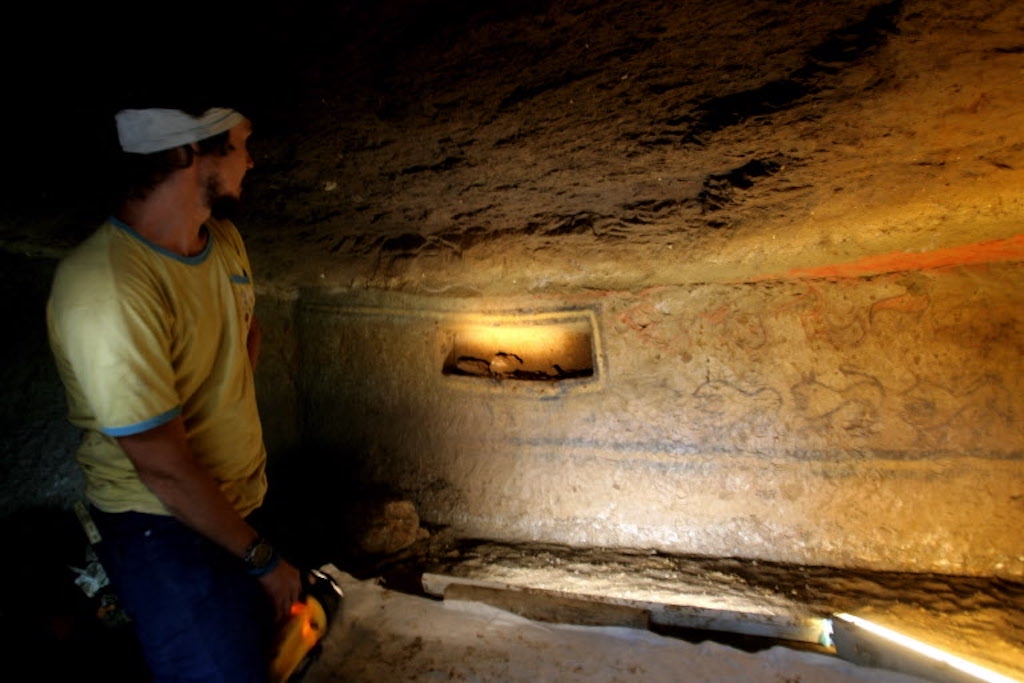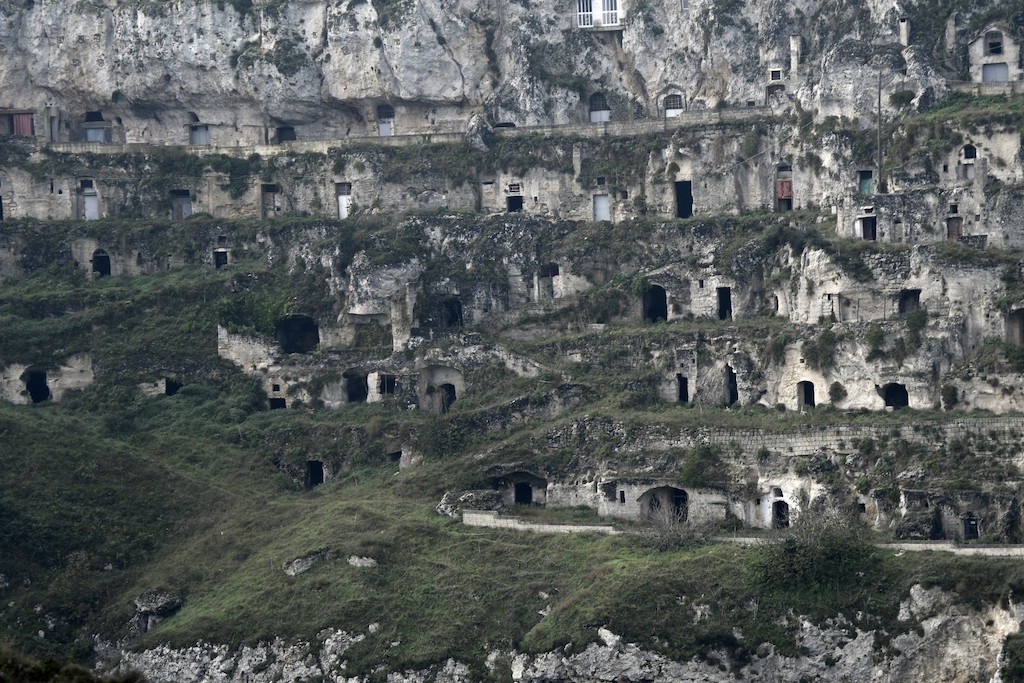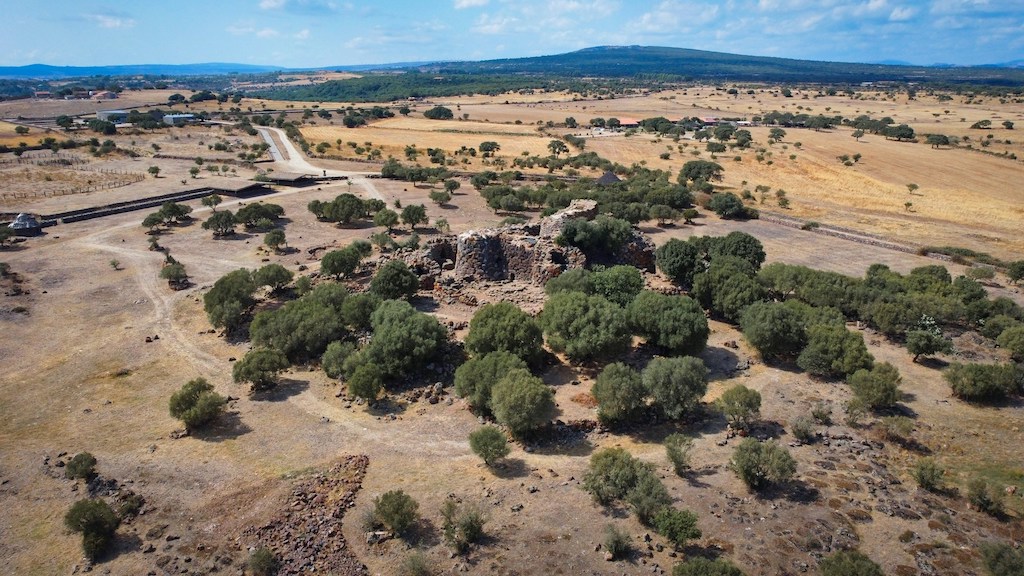Five pre-Roman sites to visit in Italy

From the mountains of Lombardy to the shores of Sicily, there are traces of pre-Roman civilisations scattered across Italy - if you know where to look.
The Romans may be Italy's best-known ancient civilisation, but with Rome tracing its foundations back to 753 BC, they were far from the first to get here.
From the Etruscans to the Greeks, a suprising number of early human societies left their mark on the Italian peninsula, with temples, fortifications, theatres and graveyards.
Here are five historic sites you can visit in Italy that pre-date the Romans.
Etruscan necropoli of Cerveteri and Tarquinia
The Etruscan civilisation, with its heartlands in modern-day Lazio, Tuscany and Umbria, at one time dominated Italy until it was wiped out in the Roman-Etruscan wars in the 4th century BC.
These days not much remains of the Etruscans beyond earthenware and sarcophagi, but we do have some impressive necropolises or 'cities of the dead' that served as graveyards.
READ ALSO: Four civilizations in Italy that pre-date the Roman Empire
One of the best preserved is in Tarquinia, where not far outside the medieval city walls you'll find a complex with hundreds of painted tombs depicting ancient life.
Another is the Necropoli della Banditaccia in nearby Cerveteri, a sprawling cemetery containing thousands of large domed tombs in a city-like plan designed to mimic an actual living city.

A 7th century painted Etruscan tomb discovered outside Rome in June 2006. Photo by FILIPPO MONTEFORTE / AFP.
Matera's Neolithic caves
Used as a filming location for Pasolini's The Gospel According to St. Matthew or The Passion of the Christ thanks to its strong resemblance to ancient Jerusalem, Matera in southern Italy is believed to be Europe's oldest continually-habited settlement.
Outside of the cave dwellings carved into the rock which form the residences and hotels you'll find in the old town's Sassi districts today, the city is surrounded by caves that have been dated as far back as 7000 BC, to the Neolithic and even the Paleolothic eras.
You can see traces of prehistoric settlements and and Neolithic graveyards and villages in the Murgia Materana regional park surrounding the city.

Caves dating back to the Neolithic area surround the ancient city of Matera. Photo by Filippo MONTEFORTE / AFP.
Sardinia's nuraghi
Sardinia's Nuragic civilisation lasted from around 1,800 BC in the Bronze Age to Roman invasion and colonisation in around the first century BC, but today few traces of it remain beyond the stone structures - nuraghes or nuraghi in Italian - from which it takes its name.
READ ALSO: Five surprising facts you didn't know about Rome
Around 7,000 nuraghi, truncated cone-like edifices made from stacked stones and boulders, dot the island's landscape. Historians debate their function: they might have served as fortresses, residences, temples, astronomical observatories, or a combination of any of these.
The Su Nuraxi di Barumini nuraghe complex in the south of the island is a UNESCO World Heritage-listed site, and is considered one of the best examples of the architecture.

An aerial view of Nuraghe Arrabiu, one of the largest nuraghi on Sardinia. Photo by Joran Quinten on Unsplash
Valcamonica's pre-historic stone carvings
In Italy's mountainous northern Lombardy region you can find one of the world's largest collections of petroglyphs, or rock carvings, spanning eight millennia and dating as far back as the Epipaleolithic era, around 10,000 years ago.
The 300,000-odd carvings, found in multiple locations across the 90km-long valley, were Italy's first recognised World Heritage site, coming under UNESCO protection in 1979.
Today, there are eight archeological parks you can visit to see the engravings in person, with the 140 rocks in the Naquane National Park of Rock Engravings considered some of the best preserved.

A British Museum employee dusts a carved stone dated 2,500 BC, from Capo di Ponte, Valcamonica, for a 2022 exhibition. Photo by Daniel LEAL / AFP.
Agrigento's Valley of the Temples
From architecture to military strategy, the Romans were heavily influenced by the Greeks - which is no surprise considering that large parts of southern Italy were once part of ancient Greece.
'Magna Grecia', 'Great[er] Greece' as the Romans called it, started being settled by the Greeks from around the eighth century BC, and at its height stretched across modern-day Sicily, Calabria, Puglia, Campania and Basilicata.
READ ALSO: Did you know...? These parts of Italy were once part of ancient Greece
Scattered across southern Italy are the remains of Greek settlements, including soaring temples and ancient theatres.
One of the most renowned and impressive examples of these is the Sicilian city of Agrigento's 'Valley of Temples', where you'll find seven temples within just a few miles of each other.

The Greek Temple of Concordia in Agrigento's Valley of the Temples was built in the 5th century BC. Photo by ludovic MARIN / AFP.
Comments (1)
See Also
The Romans may be Italy's best-known ancient civilisation, but with Rome tracing its foundations back to 753 BC, they were far from the first to get here.
From the Etruscans to the Greeks, a suprising number of early human societies left their mark on the Italian peninsula, with temples, fortifications, theatres and graveyards.
Here are five historic sites you can visit in Italy that pre-date the Romans.
Etruscan necropoli of Cerveteri and Tarquinia
The Etruscan civilisation, with its heartlands in modern-day Lazio, Tuscany and Umbria, at one time dominated Italy until it was wiped out in the Roman-Etruscan wars in the 4th century BC.
These days not much remains of the Etruscans beyond earthenware and sarcophagi, but we do have some impressive necropolises or 'cities of the dead' that served as graveyards.
READ ALSO: Four civilizations in Italy that pre-date the Roman Empire
One of the best preserved is in Tarquinia, where not far outside the medieval city walls you'll find a complex with hundreds of painted tombs depicting ancient life.
Another is the Necropoli della Banditaccia in nearby Cerveteri, a sprawling cemetery containing thousands of large domed tombs in a city-like plan designed to mimic an actual living city.

Matera's Neolithic caves
Used as a filming location for Pasolini's The Gospel According to St. Matthew or The Passion of the Christ thanks to its strong resemblance to ancient Jerusalem, Matera in southern Italy is believed to be Europe's oldest continually-habited settlement.
Outside of the cave dwellings carved into the rock which form the residences and hotels you'll find in the old town's Sassi districts today, the city is surrounded by caves that have been dated as far back as 7000 BC, to the Neolithic and even the Paleolothic eras.
You can see traces of prehistoric settlements and and Neolithic graveyards and villages in the Murgia Materana regional park surrounding the city.

Sardinia's nuraghi
Sardinia's Nuragic civilisation lasted from around 1,800 BC in the Bronze Age to Roman invasion and colonisation in around the first century BC, but today few traces of it remain beyond the stone structures - nuraghes or nuraghi in Italian - from which it takes its name.
READ ALSO: Five surprising facts you didn't know about Rome
Around 7,000 nuraghi, truncated cone-like edifices made from stacked stones and boulders, dot the island's landscape. Historians debate their function: they might have served as fortresses, residences, temples, astronomical observatories, or a combination of any of these.
The Su Nuraxi di Barumini nuraghe complex in the south of the island is a UNESCO World Heritage-listed site, and is considered one of the best examples of the architecture.

Valcamonica's pre-historic stone carvings
In Italy's mountainous northern Lombardy region you can find one of the world's largest collections of petroglyphs, or rock carvings, spanning eight millennia and dating as far back as the Epipaleolithic era, around 10,000 years ago.
The 300,000-odd carvings, found in multiple locations across the 90km-long valley, were Italy's first recognised World Heritage site, coming under UNESCO protection in 1979.
Today, there are eight archeological parks you can visit to see the engravings in person, with the 140 rocks in the Naquane National Park of Rock Engravings considered some of the best preserved.

Agrigento's Valley of the Temples
From architecture to military strategy, the Romans were heavily influenced by the Greeks - which is no surprise considering that large parts of southern Italy were once part of ancient Greece.
'Magna Grecia', 'Great[er] Greece' as the Romans called it, started being settled by the Greeks from around the eighth century BC, and at its height stretched across modern-day Sicily, Calabria, Puglia, Campania and Basilicata.
READ ALSO: Did you know...? These parts of Italy were once part of ancient Greece
Scattered across southern Italy are the remains of Greek settlements, including soaring temples and ancient theatres.
One of the most renowned and impressive examples of these is the Sicilian city of Agrigento's 'Valley of Temples', where you'll find seven temples within just a few miles of each other.

Join the conversation in our comments section below. Share your own views and experience and if you have a question or suggestion for our journalists then email us at [email protected].
Please keep comments civil, constructive and on topic – and make sure to read our terms of use before getting involved.
Please log in here to leave a comment.